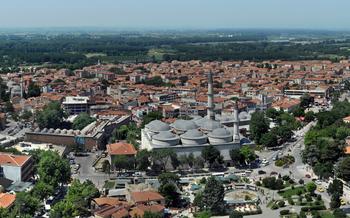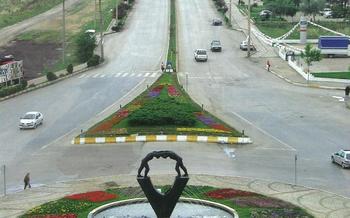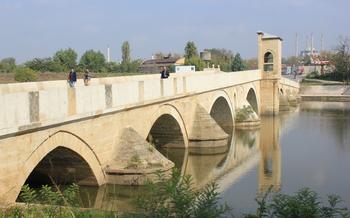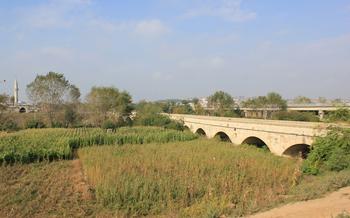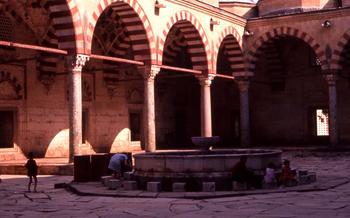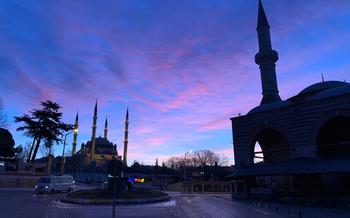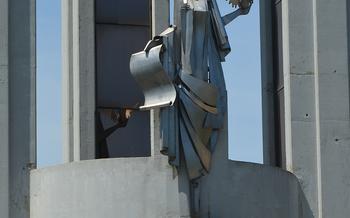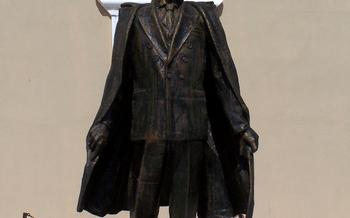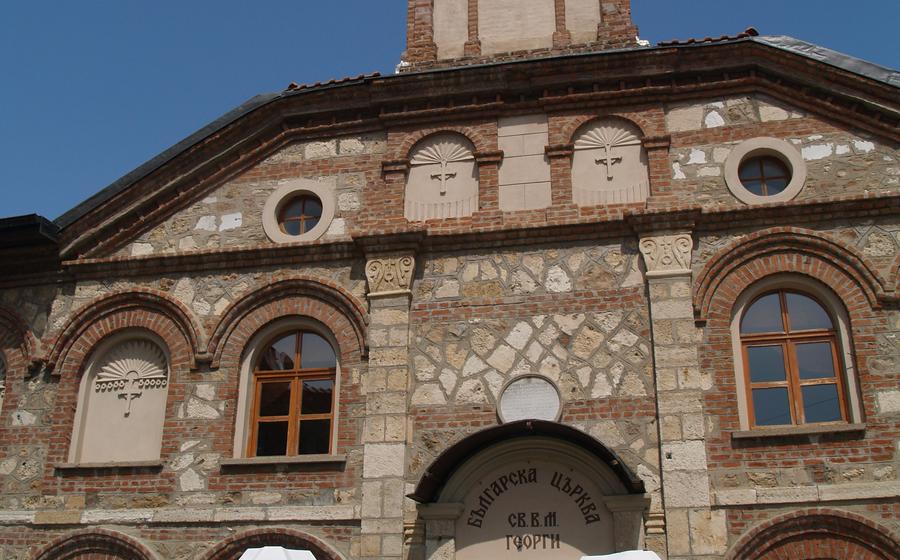
Sweti George Church
- Sweti George Church: A Testament to Bulgarian Heritage
- Architectural Marvel
- Religious Symbolism
- Cultural Landmark
- Restoration and Preservation
- Visiting Information
- Historical Context
- Bulgarian Community
- Local Traditions
- Photography Tips
- Accessibility
- Guided Tours
- Local Cuisine
- Insider Tip: Unveiling Edirne's Culinary Delights
Sweti George Church: A Testament to Bulgarian Heritage
Standing majestically in the heart of Edirne, Turkey, the Sweti George Church, also known as the Bulgarian Church, is a testament to the resilience and cultural heritage of the Bulgarian community in the region. Built in 1880 by master builder Usta Dimitar, the church is a striking example of the fusion of Byzantine and Ottoman architectural styles. It is affiliated with the Bulgarian Orthodox Church and serves as an important religious and cultural symbol for the Bulgarian minority in Turkey.
Throughout the tumultuous periods in the region's history, the Sweti George Church faced numerous challenges. In the early 20th century, during the Balkan Wars, the church suffered significant damage and was temporarily closed. During the communist era in Bulgaria, the church's activities were restricted, and its congregation faced persecution. Despite these adversities, the church remained a beacon of hope and a source of spiritual strength for the Bulgarian community, symbolizing their unwavering faith and cultural identity.
Architectural Marvel
The Sweti George Church stands as a testament to the fusion of Byzantine and Ottoman architectural traditions. Its exterior facade captivates with intricate brick and stonework, showcasing the skill and artistry of its builders. The church's bell tower, a striking feature that rises above the cityscape, invites visitors to marvel at its grandeur and precision. Intricate carvings adorn the exterior walls, depicting religious scenes and motifs that add depth and symbolism to the church's design.
Stepping inside the church, visitors are greeted by a breathtaking interior adorned with vibrant frescoes and a magnificent iconostasis. The frescoes, meticulously painted by talented artists, narrate biblical stories and depict saints and religious figures with remarkable detail and expression. The iconostasis, a stunning partition that separates the nave from the sanctuary, is adorned with intricate carvings and icons that evoke a sense of awe and reverence. The church's interior is a testament to the artistic and spiritual heritage of the Bulgarian Orthodox community, showcasing the beauty and splendor of Eastern Christian art.
Religious Symbolism
The Sweti George Church holds immense religious significance as a place of worship for the Bulgarian Orthodox community in Edirne. Throughout the centuries, it has served as a spiritual center for the Bulgarian Orthodox faithful, fostering a deep sense of religious identity and continuity. Parishioners gather within the church's sacred walls to celebrate religious rituals and traditions, such as the Divine Liturgy, baptisms, weddings, and other important events in the Orthodox Christian calendar.
The church's interior is adorned with beautiful frescoes and iconography, depicting scenes from the Bible and the lives of saints. These exquisite works of art not only enhance the church's aesthetic appeal but also serve as powerful reminders of the church's deep religious roots and connection to the broader Orthodox Christian tradition. The iconostasis, a wall of icons that separates the nave from the sanctuary, is a particularly striking feature of the church. It features a collection of intricately painted icons, each representing a different saint or figure from the Orthodox Christian tradition.
Beyond its role as a place of worship, the Sweti George Church has played a vital role in preserving and promoting Bulgarian Orthodox culture and traditions. It has served as a gathering place for the Bulgarian community, where people can come together to socialize, exchange ideas, and share their cultural heritage. The church has also been instrumental in organizing cultural events, such as concerts, exhibitions, and festivals, that celebrate Bulgarian Orthodox traditions and showcase the community's rich cultural tapestry.
Cultural Landmark
The Sweti George Church stands as a prominent cultural landmark in the city of Edirne, deeply embedded in the cultural identity of the region. Its architectural grandeur and religious significance have made it a symbol of cultural heritage and a source of pride for the local community. The church has played a pivotal role in shaping the cultural landscape of Edirne, serving as a venue for religious ceremonies, cultural events, and community gatherings.
Throughout the year, the church hosts various cultural events that celebrate Bulgarian traditions and promote cultural exchange. These events include traditional Bulgarian dance performances, music concerts, art exhibitions, and educational workshops. Visitors can immerse themselves in the vibrant Bulgarian culture and witness the passion and dedication of the local community in preserving their heritage.
The Sweti George Church is a living testament to the rich cultural diversity of Edirne. Its existence as a cultural landmark serves as a reminder of the importance of preserving and celebrating the cultural heritage of minority communities. Visitors to the church can not only marvel at its architectural beauty but also gain a deeper understanding of the cultural tapestry that makes Edirne a unique and fascinating city.
Restoration and Preservation
The Sweti George Church has undergone several restoration and preservation efforts throughout its history to maintain its architectural integrity and cultural significance. In the early 20th century, the church underwent a major renovation that involved repairing structural damage and restoring its frescoes and iconostasis. In recent years, further restoration projects have been undertaken to address issues such as water damage and aging masonry.
Preserving the church's historical and cultural value has been a priority for the Bulgarian Orthodox community. Through the dedication and efforts of local organizations and individuals, the church has been successfully restored to its former glory. Ongoing maintenance and preservation projects ensure that future generations can continue to appreciate the beauty and significance of this sacred site.
One notable success story is the restoration of the church's bell tower. In 2015, the tower underwent extensive repairs and reinforcement to ensure its stability. This successful project not only preserved a vital part of the church's structure but also restored its iconic silhouette to the Edirne skyline.
Visiting Information
Visiting the Sweti George Church is a rewarding experience that offers a glimpse into the rich history and culture of Edirne. The church is located in the heart of the city, easily accessible on foot or by public transportation. It is open to visitors daily, with extended hours during the summer months. Admission to the church is free of charge, allowing everyone to appreciate its beauty and significance.
To fully appreciate the church's tranquil atmosphere and intricate details, it is recommended to visit during the weekdays, avoiding the weekend crowds. Early mornings or late afternoons offer the best lighting conditions for photography enthusiasts. Combining a visit to the Sweti George Church with other nearby attractions, such as the Selimiye Mosque or the Edirne Museum, provides a comprehensive exploration of the city's diverse cultural heritage.
Historical Context
The Sweti George Church stands as a testament to the rich and complex history of Edirne, a city that has been shaped by diverse cultural and religious influences. During the Ottoman Empire, Edirne served as the capital and played a pivotal role in the empire's political, economic, and cultural development. The city's strategic location at the crossroads of Europe and Asia made it a melting pot of different ethnicities and religions, including the Bulgarian Orthodox community.
The construction of the Sweti George Church in the 19th century coincided with a period of relative religious tolerance within the Ottoman Empire. The Bulgarian Orthodox community, seeking to establish a permanent place of worship, received permission from the Ottoman authorities to build the church. The church's construction not only fulfilled the spiritual needs of the Bulgarian community but also symbolized their growing influence and presence in the city.
Throughout its history, the Sweti George Church has faced various challenges and undergone periods of restoration. During the tumultuous Balkan Wars and the subsequent population exchanges between Greece, Bulgaria, and Turkey, the church faced threats of destruction and abandonment. However, thanks to the resilience and dedication of the Bulgarian Orthodox community, the church survived these turbulent times and continues to serve as a sacred and cherished symbol of their faith and cultural heritage.
Bulgarian Community
The Bulgarian community in Turkey has a rich history and cultural heritage, with the Sweti George Church playing a pivotal role in preserving and promoting their identity. For centuries, the church has served as a spiritual and cultural center for the Bulgarian minority in Edirne, providing a sense of community and belonging. Through its religious services, cultural events, and educational initiatives, the church has been instrumental in keeping Bulgarian traditions and customs alive.
One of the most significant contributions of the church to the Bulgarian community is its role in preserving the Bulgarian language and culture. Throughout history, the church has been a place where Bulgarian language classes have been taught, ensuring that future generations can communicate in their mother tongue. Additionally, the church has been a repository for Bulgarian literature, music, and art, helping to preserve and showcase the rich cultural heritage of the Bulgarian people.
The Sweti George Church has also played a crucial role in fostering a sense of unity and solidarity among the Bulgarian community in Edirne. By providing a shared space for religious observances, cultural celebrations, and community gatherings, the church has created a strong bond among its members. This sense of unity has been particularly important during challenging times, helping the Bulgarian community to navigate periods of adversity and to maintain their cultural identity in a foreign land.
Local Traditions
The Sweti George Church and the Bulgarian Orthodox community in Edirne are closely intertwined with several local traditions and customs that hold deep cultural significance. One notable tradition is the annual celebration of St. George's Day, which takes place on May 6th. During this festival, the church becomes the focal point of festivities, with special religious services, processions, and communal gatherings. Locals gather to honor St. George, the patron saint of the church, and celebrate their shared heritage.
Another significant tradition is the observance of religious holidays according to the Bulgarian Orthodox calendar. The church follows the Julian calendar, which differs from the Gregorian calendar used in most countries. As a result, holidays such as Christmas and Easter are celebrated on different dates than in other parts of the world. These celebrations are marked with unique rituals, feasts, and customs that reflect the rich traditions of the Bulgarian Orthodox faith.
Visitors to the Sweti George Church can respectfully observe these local traditions and gain insights into the cultural heritage of the Bulgarian community. By attending religious services, participating in festivals, and interacting with locals, visitors can experience the vibrant and welcoming spirit of this community. It is important to be respectful of local customs and traditions, such as dressing appropriately and observing any specific guidelines or restrictions during religious ceremonies.
Photography Tips
Capture the Grand Exterior: Position yourself at a distance to capture the church's imposing facade, highlighting its intricate brickwork, stone carvings, and the striking bell tower reaching towards the sky.
Play with Light and Shadows: Visit during the golden hours of sunrise or sunset to witness the church bathed in warm, diffused light. The interplay of light and shadows will create dramatic and visually captivating images.
Explore Interior Details: Step inside the church and focus on the beautiful frescoes, iconostasis, and other religious artifacts. Use a wide-angle lens to capture the grandeur of the interior or zoom in for close-up shots of intricate details.
Find Unique Perspectives: Don't be afraid to experiment with different angles and vantage points. Climb the bell tower for a bird's-eye view of the church and the surrounding cityscape, or capture unique shots from the church's courtyard or gardens.
Respect the Sacred Space: Remember that the church is an active place of worship, so be respectful of ongoing religious ceremonies or services. Avoid using flash photography or making loud noises that might disturb worshippers.
Accessibility
The Sweti George Church is committed to ensuring accessibility for visitors with disabilities or special needs. The church features a wheelchair-accessible ramp at the main entrance, allowing visitors to enter and exit the building with ease. Additionally, there are designated wheelchair spaces within the church, enabling visitors to participate in religious services and ceremonies comfortably. Visitors with hearing impairments can request assistive listening devices to enhance their participation in religious activities. Our goal is to create an inclusive environment where everyone can experience the beauty and spirituality of the Sweti George Church regardless of their physical abilities.
Guided Tours
Guided tours of the Sweti George Church are available for visitors who wish to delve deeper into its history, architecture, and religious significance. These tours are led by knowledgeable guides who provide insightful commentary and anecdotes that bring the church's story to life. Visitors can choose from general history tours that cover the church's construction, affiliation with the Bulgarian Orthodox community, and role as a cultural symbol, or opt for more in-depth religious tours that explore the church's rituals, traditions, and iconography.
Guided tours are offered at various times throughout the day and can be booked in advance or arranged upon arrival at the church. Prices for tours vary depending on the size of the group and the duration of the tour. Visitors can inquire about tour availability and pricing at the church's information desk or through local tour operators.
Taking a guided tour of the Sweti George Church is a highly recommended way to gain a comprehensive understanding of its historical, cultural, and religious significance. The knowledgeable guides provide valuable insights that enrich the visitor experience and leave a lasting impression of this remarkable architectural and spiritual treasure.
Local Cuisine
When exploring Edirne, don't miss the opportunity to savor the local cuisine, which blends Turkish and Bulgarian culinary traditions. For an authentic Turkish experience, try traditional dishes like "ciğer tava" (pan-fried liver), "kavurma" (slow-cooked meat), or "köfte" (meatballs). These dishes are often served with fresh bread or rice.
For a taste of Bulgarian cuisine, seek out restaurants that serve dishes like "banitsa" (a savory pastry filled with cheese or spinach), "tarator" (chilled yogurt soup with cucumbers and walnuts), or "shopska salad" (a refreshing mix of tomatoes, cucumbers, onions, and peppers).
One must-try dish in Edirne is "Edirne tava ciğeri," a local specialty made with pan-fried liver, onions, and spices. It's a hearty and flavorful dish that's sure to satisfy your taste buds.
To accompany your meal, sip on a glass of Turkish tea, a refreshing beverage that's deeply ingrained in the local culture. And for a sweet treat, indulge in "lokum," also known as Turkish delight, a colorful and delectable confection made with sugar, starch, and flavorings.
Insider Tip: Unveiling Edirne's Culinary Delights
As you explore the enchanting city of Edirne, don't miss the opportunity to savor its delectable cuisine. Just a short stroll from the Sweti George Church, nestled in the heart of the old town, you'll find a hidden gem called "Tarihi Edirne Köftecisi." This charming eatery has been serving mouthwatering traditional Turkish meatballs for over a century. Sink your teeth into their succulent köfte, expertly grilled to perfection and bursting with flavor. Pair your meal with a refreshing glass of ayran, a yogurt-based beverage, and indulge in the authentic culinary experience that Edirne has to offer.
